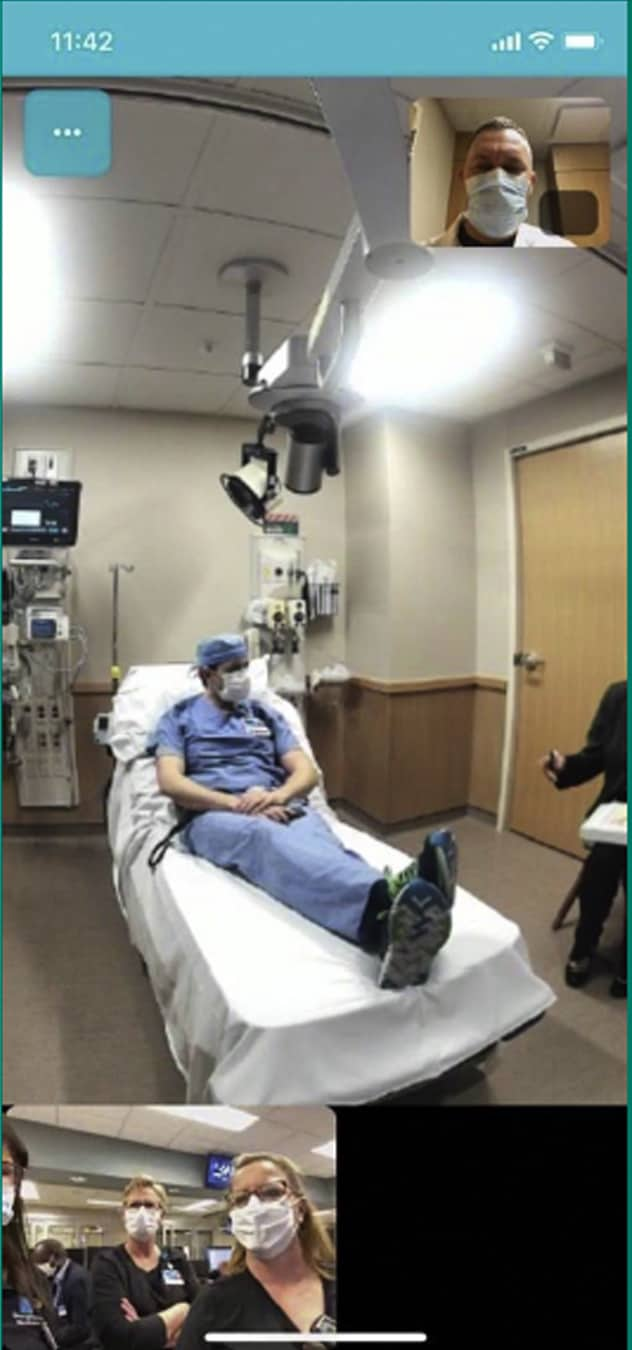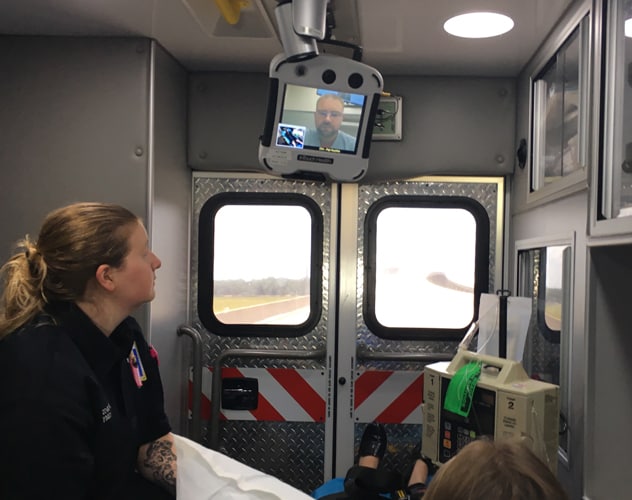Jan. 23, 2021
Mayo Clinic has enhanced its use of telemedicine during the coronavirus disease 2019 (COVID-19) outbreak to safeguard health care workers while optimizing patient care. Mayo's positive experience provides a potential model for post-pandemic care.
"Prior to COVID-19, telemedicine was approved primarily for rural areas. During COVID-19, telemedicine has become a powerful tool for delivering care at our academic campuses. Post-COVID-19, we don't envision going back," says William D. Freeman, M.D., a neurocritical care specialist at Mayo Clinic in Jacksonville, Florida.
Mayo Clinic's campus in Arizona pioneered the use of telemedicine for patients in underserved areas, particularly for the treatment of stroke. Although stroke telemedicine was extended to Mayo's campuses in Florida and Minnesota and to Mayo Clinic Health System sites, the broader use of telemedicine was limited by government regulations involving, for example, state licensure and health insurance reimbursement. In response to the COVID-19 pandemic, those obstacles were eased. As a result, Mayo Clinic extended its Emergency Medicine Telehealth (TeleEM) program to its campuses in Arizona, Florida and Rochester, Minnesota.
Digital connections with patients rose from fewer than 500 a day pre-pandemic to more than 8,000 a day in April 2020. "Since then, although our inpatient and outpatient in-person visits have been restored, we are still conducting nearly 5,000 digital connections a day," says Bart M. Demaerschalk, M.D., a neurologist at Mayo Clinic in Phoenix/Scottsdale, Arizona, chair of Stroke and Cerebrovascular Diseases and medical director of Mayo Clinic's Telestroke Service. "We have demonstrated that our digital connections not only are scalable — they are also sustainable. Survey responses from our patient population and our providers have been highly favorable."
As described in the October 2020 issue of Mayo Clinic Proceedings, some of the many benefits of telemedicine during the pandemic include:
- Conservation of personal protective equipment (PPE)
- Reduced exposure of staff to the COVID-19 virus
- Efficient use of emergency department exam rooms
The lessons learned during the pandemic are likely to change future health care. "COVID-19 has pushed us to try new approaches," says Rabih G. Tawk, M.D., a neurovascular surgeon at Mayo Clinic's campus in Florida. "Patients have become more proficient with technology. We have found that many follow-up visits can be done over video. Not every patient needs to spend time and expense to travel."
Facilitating a multidisciplinary approach
Telemedicine aligns well with Mayo Clinic's integrated practice and multispecialty approach to patient care. The TeleEM team is able to remotely gather specialists in neurocritical care, critical care, telestroke, teleneonatology, pediatric intensive care and cardiology.
通过远程医疗进行多学科评估

通过远程医疗进行多学科评估
远程医疗可让多个参与者远程检查患者。
"The biggest benefit of telemedicine pre-, during or post-COVID-19 is that we can offer subspecialized care to the right person in the right place at the right time," says Deena M. Nasr, D.O., a neurologist at Mayo Clinic in Rochester, Minnesota, and the site medical director for Mayo's telestroke core team in the Midwest. "It's the new standard of quality care for subspecialized areas."
The benefits are apparent at multiple stages of patient care. During the pandemic, telemedicine has made triage in Mayo Clinic's emergency departments more efficient.
"Stable patients with suspected COVID-19 but no respiratory distress don't require full emergency department exam rooms," Dr. Demaerschalk says. "Those patients can be tested for COVID-19 and remotely examined by a physician, which keeps critical emergency department rooms open for more acutely ill patients."
Patients can also be monitored remotely. Dr. Demaerschalk notes that considerable amounts of PPE are consumed by health care workers briefly entering patients' rooms to assess pain and the need for therapeutics. Remote monitoring minimizes those contacts.
Daily hospital rounds also can be done remotely. "Instead of a large group of nurses, trainees and a neurological consultant gathering at the bedside, we usually now have a representative from our neurological hospital team put on PPE and enter the COVID-19 environment," Dr. Demaerschalk says. "The other team members gather together and are able to ask questions and to discuss the diagnosis and management plans without putting themselves at risk or unnecessarily utilizing PPE."
院前远程医疗

院前远程医疗
妙佑医疗国际的工作人员演示在救护车中使用远程医疗。
Even before the COVID-19 pandemic, Mayo Clinic began using telemedicine in ambulances transporting patients to the emergency departments at Mayo's campuses in Arizona and Florida. For the past five years, Mayo Clinic stroke neurologists have been able to remotely conduct National Institutes of Health (NIH) Stroke Scale testing before patients arrive at the hospital.
"We realized that if we got our eyes on the patients earlier, we could tailor the care they needed," Dr. Freeman says. "It's sort of like NASCAR — we know what the patients need by the time they roll up."
The early assessments have cut eight to 10 minutes from the time needed to obtain CT scans. "In large vessel occlusion strokes, one minute of faster treatment saves about 1.9 million neurons," Dr. Freeman says. "Doing the NIH Stroke Scale in the ambulance potentially saves 19 million neurons."
Potential new uses
Telemedicine might possibly be used for the diagnosis of patients presenting with certain new subacute neurological conditions. Mayo Clinic has launched a study comparing the accuracy of a provisional video telemedicine diagnosis and an in-person reference standard diagnosis for each of 2,600 study participants.
"We will compare the provisional diagnosis from the telemedicine consultation with the definitive reference diagnosis offered after in-person evaluation and any diagnostic studies," Dr. Demaerschalk says. "Our goal is to more clearly understand where video telemedicine consultations have added value and where there may be vulnerabilities."
Mayo Clinic is also working to incorporate robotic technology into care for patients who require neurological surgery. Robot-assisted spinal surgery is performed at all three campuses. Eventually, Mayo Clinic neurosurgeons might have the capability to robotically examine patients or even perform minimally invasive procedures on patients in other states or countries.
"That work is very much in its infancy," Dr. Freeman says. "But we're trying to think on a worldwide scale and to pioneer the next wave of robotic technology."
Mayo Clinic's use of technology is a key aspect of patient-centered care. "We have always seen the potential for wider use of telemedicine. But COVID-19 really solidified that need," Dr. Nasr says. "This patient-centered approach exemplifies the Mayo Clinic model of care."
For more information
Telestroke Service (stroke telemedicine). Mayo Clinic.
Russi CS, et al. Emergency medicine telehealth for COVID-19: Minimize front-line provider exposure and conserve personal protective equipment. Mayo Clinic Proceedings. 2020;95:2065.
Critical Care Medicine. Mayo Clinic.
Teleneonatology Program. Mayo Clinic.